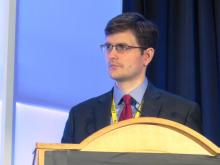HOLLYWOOD, FLA. –
The 4-year review found that 21% of older patients with a confirmed C-spine fracture reported no pain on history or physical exam, and that 76% of these fractures needed treatment – twin findings suggesting that asymptomatic neck fractures may be undiagnosed and untreated in this population.
The 183-patient study also found no significant pain differences between age groups: The silent injuries were just as common among 55-year-olds as among 65-year-olds, Christopher Healey, MD, said at the annual scientific assembly of the Eastern Association for the Surgery of Trauma.
“I guess we can say, ‘55 is the new 65,’ when it comes to this injury,” said Dr. Healey of the Iowa Methodist Medical Center, Des Moines. “In our study the rate of a pain-free neck fracture in 55-year-olds was equivalent to that in their older counterpoints, so they also represent a group at increased risk.”
Dr. Healey and his colleagues conducted a 4-year review of trauma patients aged 55 years and older who were treated for a C-spine fracture. All of the patients had a Glasgow Coma
Score of 15 at the time of their clinical exam, so they would have been fully aware of any sensation or pain associated with the fracture and fully capable of communicating such. However, 38 (21%) reported no pain either in their history or upon physical exam.There were no differences in the mechanism of injury between the pain-free and pain-positive groups. The most common source of injury was a fall from the person’s own height (39% vs. 49%), followed by a high fall (21% vs. 19%). Motor vehicle crashes came in third (37% vs. 30%), with other methods of injury accounting for about 3% of each group.
The level of fracture was widely dispersed among both groups and not associated with pain. Asymptomatic fractures occurred at C1 and C2 vertabrae (about 13%); C3 (26%); C4 (10%); C5 (12%); and C6 and C7 (30%).
Perhaps surprisingly, patients who didn’t report pain had significantly higher Injury Severity Scores (15 vs. 10). They were also significantly more likely to have injuries to other body regions (71% vs. 47%), including the head (22% vs. 16%), thorax/abdomen (39% vs. 20%), and extremities (33% vs. 20%).
A third of those with a pain-free fracture had breaks at multiple levels. Their hospital stays were significantly longer than were those of patients with painful fractures (7 vs. 5 days).
These findings of more severe injuries in the asymptomatic group led Dr. Healey to suggest that distracting pain might be playing a part in the phenomenon.
When the group was split into 10-year age increments, asymptomatic fractures occurred in about 20% of each group from 55-64 years up to 85 years and older.
The majority of both groups required treatment (91% with pain; 76% asymptomatic), Dr. Healey said. The most common treatment in each group was a cervical collar (61% with pain vs. 46% asymptomatic ). A cervical-thoracic-lumbar-sacral orthosis brace was used in 8% of those with pain and 11% of the asymptomatic patients.
Invasive procedures were performed in just as many of the asymptomatic patients as in those who had pain. These included vertebral fusion (11% asymptomatic vs. 9% with pain) and cervical halo (8% vs. 13%).
The lesson here, Dr. Healey concluded, is that pain is not always a reliable indicator of neck injury in older patients. “Older adults can break their neck and have no pain at all. This is concerning, because the presence or absence of neck pain is a major component in many clearance protocols for C-spine trauma. This begs the question whether we should be treating our older patients by general adult guidelines. I would advocate the development of trauma guidelines that are specific for the older or geriatric patient.”
Dr. Healey had no financial disclosures.


